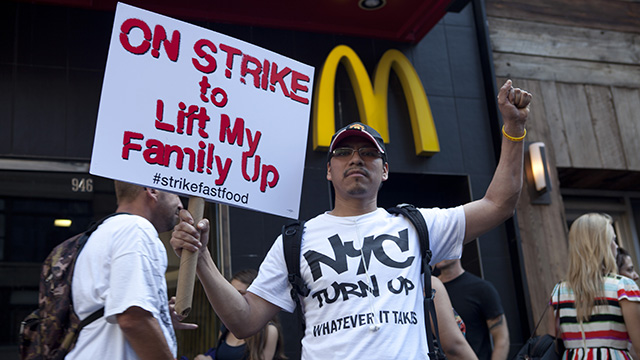This post first appeared at Economic Policy Institute blog.

On September 4, 2014, a protester holding a sign that says “On Strike to Lift My Family Up” was in front of a McDonald’s restaurant near Columbus Circle in New York City. (Photo: Charina Nadura/ Moyers & Company)
The Washington Post published an editorial on the “wage freeze” on Sunday, revealing the emptiness of its analysis and offering no recommendations for generating wage growth. At least there was acknowledgment of the problem, that “middle-class family incomes are still not growing very much” and “average income for the bottom 90 percent of households has barely grown at all, in real terms, over the last four decades.”
The question of why we should care was answered with:
“If you believe that democracy’s social foundation is a strong middle class, this trend is worrisome not only for its human cost, but also for the threat it poses to US political health.”
So far so good, the problem is widespread (the entire bottom 90 percent), it is long-term (last four decades) and it matters (for our democracy). I agree.
What shall we do? The editorial says we need to acknowledge how “difficult it will be to reverse middle-class income stagnation” and offers no suggestions whatsoever. I guess that’s better than bad suggestions, such as tax cuts, either temporary or permanent, or the idea that sending more people to college is the answer (it is not: the wages of college graduates are stagnant, especially young college grads, many of whom are working in jobs that don’t require a college degree. Remember, the problem afflicts the bottom 90 percent!).
Mostly the Washington Post issues a smug assessment that “[n]othing in the last four decades refutes the basic case for flexible, innovative, American-style capitalism,” but then immediately negates this conclusion by saying: “if the system doesn’t work for the middle class, it really isn’t working at all.” If, in fact, the economy is not working for most then perhaps it is worth challenging the way the economy operates, including many of the ways the Post advocates it should operate!
It is a positive thing that the beltway crowd is starting to talk about wages. After all, the paper we released at the launch of our Raising America’s Pay initiative was titled “Raising America’s Pay: Why It’s Our Central Economic Policy Challenge.” Wages are central for the simple reason that the vast middle class, as well as low-income households, rely primarily on their wage income to support their spending. And policies can restore wage growth. Let us start with Federal Reserve policy assuring a strong jobs recovery that gets unemployment down to where real wages grow at least as fast as productivity growth (which means nominal wage growth at least 3.5 to 4.0 percent). Large scale infrastructure spending would be wise as well. Yes, President Obama should allow millions of undocumented workers to work legally, thereby eliminating their vulnerability to exploitation and consequently raising their wages, which would then lift up other workers’ wages as well. Low wage workers (the bottom fifth) earn less than they did in 1968 despite a doubling of productivity and far more education simply because we have failed to adequately increase the minimum wage. We can end wage theft, raise overtime eligibility for six million workers and end the misclassification of employees into independent contractors. We can use federal legislation to restore collective bargaining for those who want it and we can oppose the actions in the states that have weakened collective bargaining, initiatives that are expected to continue this year. And why do we need new global trade agreements that will serve to put more downward pressure on wages? (I don’t see any effort of the “winners compensating the losers” from trade.)
Most of all, economic policy should take creating goods jobs and lifting wages as its central concern. This is not what happened in the four decades of “flexible, innovative, American-style capitalism” to which The Washington Post looks so fondly.
The views expressed in this post are the author’s alone, and presented here to offer a variety of perspectives to our readers.


